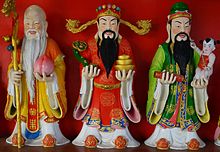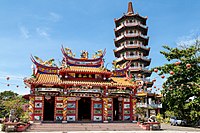Sanxing (deities) (original) (raw)
From Wikipedia, the free encyclopedia
Gods of three stars in Chinese religion
| Sanxing | |
|---|---|
 Shou, Lu, and Fu gods at a Chinese folk religious temple in Mong Kok, Hong Kong Shou, Lu, and Fu gods at a Chinese folk religious temple in Mong Kok, Hong Kong |
|
| Chinese name | |
| Traditional Chinese | 福祿壽 |
| Simplified Chinese | 福禄寿 |
| TranscriptionsStandard MandarinHanyu PinyinFú Lù ShòuYue: CantoneseYale RomanizationFūk Luhk SauhJyutpingFuk1 Luk6 Sau6Southern MinHokkien POJHok-lo̍k-siū | |
| Vietnamese name | |
| Vietnamese alphabet | Phúc Lộc Thọ |
| Chữ Hán | 福祿壽 |
| Japanese name | |
| Kanji | 福禄寿 |
| TranscriptionsRomanizationFuku Roku Ju | |
The Sanxing (Chinese: 三星; pinyin: sānxīng; lit. 'Three Stars') are the gods of the three celestial bodies considered essential in Chinese astrology and mythology: Jupiter, Ursa Major, and Canopus. Fu, Lu, and Shou (traditional Chinese: 福祿壽; simplified Chinese: 福禄寿; pinyin: Fú Lù Shòu; Cantonese Yale: Fūk Luhk Sauh), or Cai, Zi and Shou (財子壽) are also the embodiments of Fortune (Fu), presiding over the planet Jupiter, Prosperity (Lu), presiding over Mizar (ζ Ursa Majoris), and Longevity (Shou), presiding over Canopus. They have emerged from Chinese folk religion. Their iconic representation as three, old, bearded, wise men dates back to the Ming dynasty,[1] when the gods of the three stars were represented in human form for the first time. They are sometimes identified with other deities of the Chinese religion or of Taoism.
The term is commonly used in Chinese culture to denote the three attributes of a good life. Statues of these three gods are found on the facades of folk religion's temples, ancestral shrines, in homes and many Chinese-owned shops, often on small altars with a glass of water, an orange or other auspicious offerings, especially during Chinese New Year. Traditionally, they are arranged right to left (Shou on the left of the viewer, Lu in the middle, and Fu on the far right), just as Chinese characters are traditionally written from right to left.
Corresponding stars and attributes
[edit]
The Roof Decoration of Sanxing. At Magong Beiji Temple, Taiwan
The star of Fu (福), or Fuxing (Chinese: 福星; pinyin: fúxīng; lit. 'Star of fortune'), corresponds to the planet Jupiter. According to folkloric beliefs, the planet is believed to be auspicious and would bring prosperity to those who receive its light.[2]
Alternatively, according to a Ming dynasty Taoist myth, the star of fortune is associated with Yang Cheng (Chinese: 楊成),[3] a governor of Daozhou in the Tang dynasty. Yang Cheng risked his life attempting to convince the emperor to free court dwarfs kept as slaves. After his death, the people built a temple to commemorate him, and over time he came to be considered the personification of good fortune.
Fuxing is generally depicted in scholar's dress with golden trim, holding a scroll, on which is sometimes written the character "Fu" (福). He may also be seen holding a child, or surrounded by children. He is sometimes conflated with Caishen, the chinese god of wealth.
The star of Lu (祿), or Luxing (Chinese: 祿星; pinyin: lùxīng), corresponds to Mizar (ζ Ursa Majoris), or in traditional Chinese astronomy, the sixth star in the Wenchang constellation (文昌六). Like the star of Fortune, it also came to be personified, and is believed to be Zhang Xian who lived during the Later Shu dynasty.[4][5] The character "Lu" specifically refers to the salary of a government official. As such, the star of Lu is considered the deity of prosperity, rank, and influence. He is often depicted holding a Ruyi scepter.[6]
The star of Lu is also worshipped separately from the other two as the deity dictating one's success in the imperial examinations, and therefore success in the imperial bureaucracy. The star of Lu is usually depicted in the dress of a mandarin.
The star of Shou, or Shouxing (Chinese: 壽星; pinyin: Shòuxing; lit. 'Star of longevity'), corresponds to the star α Carinae (Canopus). It is also called the "star of the south pole" in Chinese astronomy, and is believed to control the lifespans of mortals. According to legend, he was carried in his mother's womb for ten years before being born, and was already an old man when delivered. He is recognized by his high, domed forehead and the peach which he carries as a symbol of immortality. The longevity god is usually shown smiling and friendly, and he may sometimes be carrying a calabash gourd filled with the elixir of life. He is sometimes conflated with Master Lao and immortals in Taoist theology.

Fu, Lu and Shou statues on the roof of Ling San Temple, a Chinese folk religion's temple in Tuaran, Sabah, Malaysia
A street altar with Fu, Lu and Shou statues during Chinese New Year 2015 in Paris, France[
 ](/wiki/File:LonggangZhen-YongGongCi-0023.jpg "This shrine to a Master Yong in a Yangxin County village, Hubei features a tablet, high in the facade, saying "The Three Stars are Present". The symbol at the top of the facade is a stylised derivation of the character shou , "longevity"")
](/wiki/File:LonggangZhen-YongGongCi-0023.jpg "This shrine to a Master Yong in a Yangxin County village, Hubei features a tablet, high in the facade, saying "The Three Stars are Present". The symbol at the top of the facade is a stylised derivation of the character shou , "longevity"")
This shrine to a Master Yong in a Yangxin County village, Hubei features a tablet, high in the facade, saying "The Three Stars are Present". The symbol at the top of the facade is a stylised derivation of the character shou , "longevity"Fukurokuju, Japanese god derived from "Shou" deity of Sanxing
He-He Er Xian (和合二仙), Immortals of Harmony and Union, associated with happy marriages
Seven Lucky Gods, similar group of Japanese auspicious deities
Tai Sui (太歲)—60 Heavenly Officials who will be in charge of each year during the Chinese sixty-year cycle
Xi (喜), a character sometimes added to form the set phrase: Fu Lu Shou Xi (福禄壽喜)
Qing Dynasty (1644-1911) Fu Lu Shou Xi coin.
- ^ (in Chinese) 福禄寿星 Archived 2006-07-22 at the Wayback Machine. British Taoist Association.
- ^ "正月二十八福星诞,老人说注意3个特点:福星高照日子旺,哪3个?". 命理学_网易订阅 (in Chinese). 2024-03-08. Retrieved 2024-05-04.
- ^ http://www.chinaknowledge.de/Literature/Religion/personssanxing.html, retrieved 11 Des 2017
- ^ "張仙大帝". 慈德慈惠堂 (in Chinese). Retrieved 2024-05-04.
- ^ "中国民间五神之禄星". 中国新闻网_梳理天下新闻 (in Chinese). 2009-12-03. Retrieved 2024-05-04.
- ^ "福祿壽三星". 財團法人大甲鎮瀾宮全球資訊網 (in Chinese). 2013-03-01. Retrieved 2024-05-23.
- Seow, Jeffrey. Fu Lu Shou: Gods of Blessings, Prosperity and Longevity, Singapore, 1999.
 Media related to Fu Lu Shou at Wikimedia Commons
Media related to Fu Lu Shou at Wikimedia Commons

